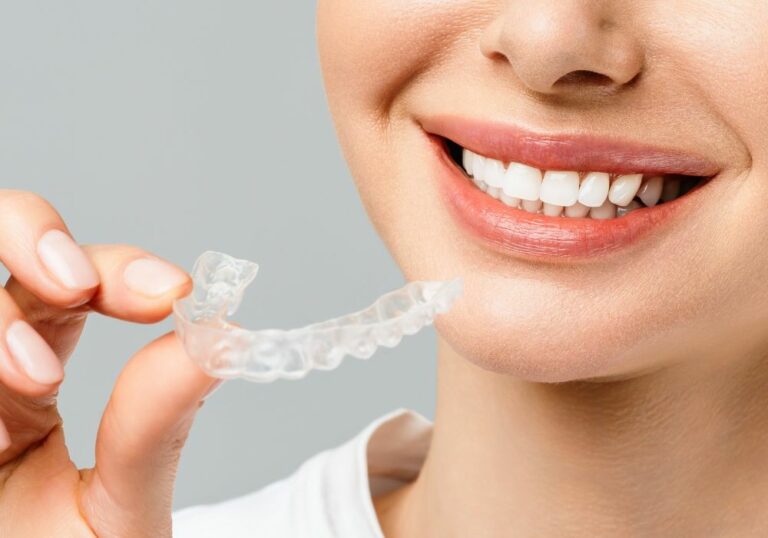What is dental varnish exactly?
Dental varnish is a specialized protective coating that is brushed or painted onto teeth to help strengthen tooth enamel, prevent cavities, and reduce sensitivity. It works by forming a thin adhesive barrier that seals off the tooth surface.
The main active ingredient in most dental varnishes is fluoride. Fluoride helps remineralize enamel and protect against acidic decay. But varnish also contains an adhesive resin that allows it to bond tightly to the irregular shapes and textures of teeth. Some other common components include:
- Natural resins – Provide adhesive properties so the varnish sticks to teeth
- Preservatives – Help the product maintain quality over time
- Solvents – Give the varnish a liquid consistency for application
- Flavoring agents – Mask bitter tastes from other ingredients
- Coloring agents – Help the dentist see where it has been applied
The exact ingredients and proportions vary by different brands and types of dental varnish. But all formulations are designed to flow freely for easy application while also quickly hardening and curing when exposed to air and moisture.
Why is dental varnish applied to teeth?

There are a few key benefits that make dental varnish a useful preventive dental treatment:
Strengthening enamel
The fluoride in varnish gets absorbed into porous areas of weakened enamel to make it more resistant to acid and decay. Fluoride helps rebuild and remineralize enamel damaged by bacterial acids.
Protective barrier
The coating seals off the tooth surface from acidic and sugary substances that promote cavities. This helps prevent demineralization of enamel.
Long-lasting
The resin allows varnish to adhere tightly to tooth surfaces while also making it durable and long-lasting in the mouth – typically 3-6 months from a single application.
Ease of application
The thin, flowable formula allows for quick and easy application on both smooth and irregular tooth surfaces. No special equipment is needed.
Fights sensitivity
Sealing off microscopic pores in enamel can reduce temperature sensitivities in teeth from hot/cold foods and drinks.
These useful benefits make dental varnish a commonly recommended procedure following dental cleanings and check-ups. Frequent varnish application provides a safe, effective way to make teeth more resistant to decay and acid damage between visits.
What happens during the varnish application process?
Application of dental varnish is quick and simple:
Cleaning – Teeth are polished and cleaned thoroughly before applying varnish so it can adhere well.
Isolation – Cheek retractors are placed so saliva will not contaminate the liquid varnish during application.
Dispensing varnish – The dentist dispenses a small amount of varnish onto an application stick or brush. The varnish flows similar to paint.
Applying to teeth – Working quickly before the varnish hardens, the dentist gently paints it onto the teeth surfaces. Additional coats may be applied to ensure full coverage.
Setting the varnish – Within minutes, the varnish sets and hardens into a thin lacquer coating tightly adhered to the teeth. The process is now complete!
Total application time is generally less than 5 minutes. The varnish will have a glossy, sticky texture at first but then quickly sets into a smooth, durable enamel shield.
Is it safe to eat and drink right after getting varnish?

Yes, it is perfectly safe to consume foods and beverages immediately after getting dental varnish applied.
The varnish sets firmly within minutes and is engineered to withstand forces from normal chewing and swallowing. Eating, drinking, and performing oral care too soon could only potentially disturb the varnish before it fully hardens.
However, dental varnishes cure rapidly. As soon as 10-15 minutes after application, the coating is unlikely to become dislodged from routine oral functions. Consuming soft foods and cool liquids shortly after application poses little risk.
Of course, it is ideal to wait at least one hour before intaking very hot foods or drinks. Higher temperatures could cause temporary expansion or softening of varnish before complete curing. But overall, don’t feel the need to avoid needed nutrition or hydration due to dental varnish. Just use reasonable care while it rapidly sets.
Are there any foods I should avoid initially?
Most foods are fine to consume shortly after getting dental varnish, but a few guidelines can help avoid accidentally dislodging it before fully cured:
- Avoid excessively chewy, crunchy or sticky foods for 3-4 hours. Things like gum, caramel, popcorn, nuts, hard candies, or dried fruit could unintentionally pull at the varnish.
- Avoid very hot or very cold foods/drinks for 1-2 hours. Extreme temperatures can impact properties while curing.
- Avoid acidic foods and beverages for 3-4 hours. High acidity could interfere with hardening.
Softer foods like eggs, pasta, fish, cooked vegetables, soup, mashed potatoes, or yogurt are good initial choices after varnish application. Beverages like water, milk, or iced tea minimize temperature extremes.
Within just a few hours, nearly any food can be consumed safely without disturbing the durable varnish. But by using care with harder or temperature-extreme foods in the first short period, you ensure the best results from the varnish treatment.
How long does dental varnish last on teeth?

A single application of dental varnish typically protects teeth for 3-6 months before gradually wearing away. Exact longevity depends on several factors:
- Varnish composition – Some brands naturally wear faster than others. Fluoride concentration and resin technology impact durability.
- Thickness of coating – More layers and thicker application provides longer-lasting protection.
- Diet and oral habits – Crunchy, sticky, and acidic foods gradually deteriorate varnish. Brushing also causes wearing.
- Teeth anatomy – Varnish may wear faster on rougher surfaces vs smooth enamel.
On average, the varnish remains visibly intact for about 2-3 months. After that, it develops some cracks and surface discoloration as it slowly wears down. By 4-6 months, most or all of the varnish coating will be gone from the teeth.
Gradual wearing allows for sustained release of protective ingredients over time. Regular reapplication extends the decay-preventing effects. Varnish does not suddenly disappear but wears slowly and progressively.
Are there risks to accidentally swallowing dental varnish?
The small amount of dental varnish that could be ingested from eating and drinking is not toxic and will not harm you. However, swallowing an excessive amount could potentially cause:
- Nausea, stomach upset, or diarrhea – The resins may taste bad or irritate the digestive tract. Effects are usually mild and temporary.
- Discolored tongue or oral tissues – Ingredients may temporarily stain the tissues a yellowish-brown tint. This is not harmful and fades in 1-2 days.
- Irritated gums or salivary glands – Components may inflame oral tissues in some people. Symptoms resolve quickly.
- Allergic reaction – Rarely, people may experience hives, itching, or swelling. Seek medical care if a severe reaction develops.
While dental varnish is formulated to minimize unintended ingestion, taking steps to avoid swallowing any excess amount is always ideal. Tell your dentist if you do experience any side effects so they can recommend the best product for future treatments.
Frequently asked questions about eating with dental varnish:
Can I drink coffee after getting dental varnish applied?
Coffee and tea are fine to drink after dental varnish application. However, it is ideal to wait 60 minutes if the coffee is piping hot. The extreme heat could impact the hardening varnish. Iced coffee or warm coffee are safer right after application.
Does dental varnish change the taste of foods?
You should not notice any taste from the dental varnish when eating and drinking. Today’s varnishes use improved formulations that quickly cure into an inert, non-reactive coating. They avoid ingredients that seep into the mouth in a way that alters flavors.
What happens if I accidentally chew gum or eat sticky candy too soon?
Sticky, chewy foods consumed too soon after application run the risk of adhering to the varnish and pulling it off before fully hardened. This will reduce its protective effects. Avoid such foods for at least 3-4 hours. If some small pieces do become unintentionally dislodged, don’t worry – just avoid going forward until it sets.
Do I need to avoid brushing after getting varnish applied?
It’s recommended to avoid brushing for at least 4-6 hours so the varnish has ample time to cure and adhere firmly. After that, resume normal oral hygiene. Brushing helps remove discoloration but also slowly wears away varnish over time through abrasion. Finding the right balance maximizes both appearance and protection.
How often do I need to get dental varnish reapplied?
Most dentists recommend getting dental varnish touch-ups every 3-6 months to maintain a protective presence on the teeth. Some patients at high risk for cavities may be treated as frequently as every 3 months. Discuss an optimal schedule for your needs with your dentist based on your dental history and risk factors.
In summary, dental varnish provides a safe, effective shield against cavities and enamel demineralization. While a little care is warranted for a short period after application, normal eating and drinking will not interfere with the varnish or pose risks from ingestion. With proper application intervals, dental varnish offers long-lasting preventive benefits to keep your smile healthy.







